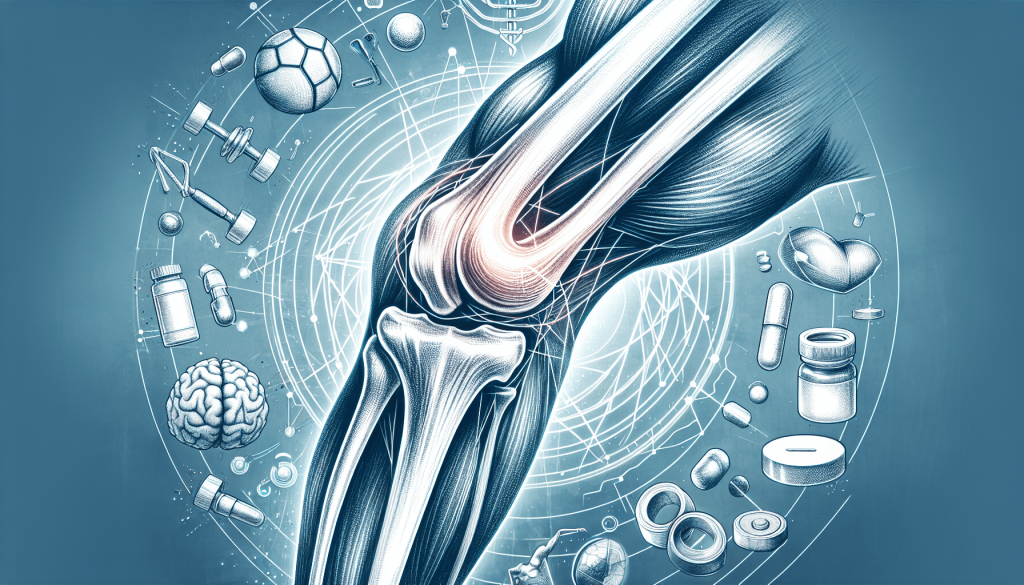Can You Strengthen Your Joints?
Are you curious about whether or not it is possible to strengthen your joints? The answer is a resounding yes! Taking care of your joints is essential for maintaining a healthy and active lifestyle, and there are various ways to improve their strength and flexibility. In this article, we will explore some effective methods and exercises that can help you enhance the strength of your joints, allowing you to move with greater ease and reducing the chances of joint-related injuries. So, let’s dive in and discover how you can strengthen your joints and improve your overall well-being.
Understanding Joint Health
Overview of Joint Health
Joint health refers to the overall well-being and functionality of your joints, which are the connections between your bones. Joints play a crucial role in facilitating movement and providing stability to your body. Understanding the factors that affect joint health and the importance of strengthening your joints can help you maintain an active and pain-free lifestyle.
Factors Affecting Joint Health
Several factors can impact the health of your joints, including age, genetics, injury, and lifestyle choices. As you age, the cartilage that cushions your joints may begin to wear down, leading to joint stiffness and pain. Genetics can also contribute to certain joint conditions, such as osteoarthritis or rheumatoid arthritis. Additionally, past injuries or repetitive motions can increase the risk of joint damage and discomfort. Lifestyle choices, such as diet and exercise, also play a significant role in maintaining joint health.
Importance of Strengthening Joints
Strengthening your joints is essential to support their overall health and functionality. Strong joints help prevent injuries, improve mobility, and reduce pain. By engaging in exercises that target the muscles surrounding your joints, you can enhance their stability and support. Additionally, strengthening exercises can improve flexibility and range of motion, allowing you to move more freely and comfortably.
Maintaining a Healthy Lifestyle
Balanced Diet
Maintaining a balanced diet is crucial for promoting joint health. Consuming a variety of nutrient-rich foods, such as fruits, vegetables, whole grains, lean proteins, and healthy fats, provides the necessary vitamins and minerals for joint health. Some specific nutrients that support joint health include calcium, vitamin D, omega-3 fatty acids, and antioxidants. Incorporating these nutrients into your diet can help reduce inflammation, strengthen bones, and support overall joint function.
Regular Exercise
Regular exercise is a key component of maintaining joint health. Engaging in physical activity helps strengthen the muscles around your joints, improves flexibility, and supports overall joint function. Cardiovascular exercises, such as walking, swimming, or cycling, can promote joint mobility and reduce stiffness. Additionally, incorporating strength training exercises can help build muscle and protect your joints from injury.
Maintaining a Healthy Weight
Maintaining a healthy weight is essential for joint health. Excess weight can put additional stress on your joints, particularly in weight-bearing areas such as the knees and hips. This increased stress can lead to joint pain and accelerate joint deterioration. By maintaining a healthy weight through a balanced diet and regular exercise, you can reduce the strain on your joints and promote long-term joint health.

Exercises to Strengthen Joints
Low-Impact Aerobic Exercises
Low-impact aerobic exercises are gentle on the joints while still providing cardiovascular benefits. Activities such as walking, swimming, and stationary biking are excellent options. These exercises help improve joint flexibility, increase blood flow to the joints, and promote overall joint health without putting excessive stress on them.
Strength Training
Strength training exercises are vital for strengthening the muscles around your joints. By targeting specific muscle groups, such as the quadriceps, hamstrings, and core, you can provide added support and stability to your joints. Incorporating exercises like squats, lunges, and resistance training with weights or resistance bands helps build muscle strength and protect your joints from injury.
Flexibility and Range of Motion Exercises
Flexibility exercises focus on stretching the muscles and connective tissues surrounding your joints. These exercises can improve joint mobility, reduce stiffness, and enhance overall flexibility. Activities such as yoga, tai chi, and Pilates are excellent options for maintaining or improving joint range of motion. Stretching exercises should be performed gently and gradually, without forcing any uncomfortable or painful movements.
Protecting Joints from Injury
Proper Body Mechanics
Practicing proper body mechanics is crucial for protecting your joints from injury. This involves maintaining good posture, using correct lifting techniques, and avoiding repetitive movements that put excessive stress on your joints. By paying attention to your body mechanics, you can minimize the risk of joint strain or damage and maintain joint health in the long term.
Use of Protective Gear
Using protective gear is essential, especially during activities that pose a higher risk of joint injury. For example, wearing knee pads or wrist guards during sports such as basketball or skateboarding can provide extra cushioning and support, reducing the impact on your joints. By taking appropriate precautions and using protective gear, you can minimize the risk of joint injuries and maintain optimal joint health.
Avoiding Repetitive Strain
Repetitive strain on your joints can lead to overuse injuries and chronic pain. To avoid this, it is important to incorporate regular breaks and vary your activities to prevent continuous stress on the same joints. If your job requires repetitive movements, take frequent breaks to stretch and rest the affected joints. Additionally, incorporating different types of exercises and activities into your routine can help distribute the workload across different joints, reducing the risk of overuse injuries.

Dietary Supplements for Joint Health
Glucosamine and Chondroitin
Glucosamine and chondroitin are popular dietary supplements that are commonly used to support joint health. They are believed to help reduce joint pain and improve joint function. Glucosamine is a natural compound found in cartilage, whereas chondroitin helps maintain the elasticity of cartilage. Although research results on their effectiveness are mixed, some individuals may experience relief from joint discomfort when taking these supplements. It’s important to consult with your healthcare provider before starting any new dietary supplements.
Omega-3 Fatty Acids
Omega-3 fatty acids are known for their anti-inflammatory properties, which can benefit joint health. They can be found in fatty fish, such as salmon and mackerel, as well as in flaxseeds and chia seeds. Adding omega-3-rich foods to your diet or taking fish oil supplements may help reduce inflammation in your joints and alleviate joint pain. As with any supplement, it is important to consult with your healthcare provider regarding the appropriate dosage and potential interactions with other medications.
Turmeric and Curcumin
turmeric and its active compound curcumin have long been used in traditional medicine for their anti-inflammatory properties. Some studies suggest that curcumin may help alleviate joint pain and inflammation associated with conditions like arthritis. Adding turmeric to your diet or taking curcumin supplements may offer some benefits for joint health. However, further research is needed to fully understand the effects and optimal dosage of curcumin for joint health.
Hot and Cold Therapy
Benefits of Heat Therapy
Heat therapy can help relax muscles, increase blood flow, and provide temporary pain relief to joints. Applying a heating pad, taking a warm bath or shower, or using heat wraps or patches can all provide soothing relief to achy joints. Heat therapy is particularly beneficial for chronic joint conditions and stiffness, as it can help improve flexibility and promote relaxation in the surrounding tissues.
Benefits of Cold Therapy
Cold therapy, also known as cryotherapy, can help reduce inflammation and alleviate acute joint pain. Applying ice packs or using cold therapy wraps can numb the area, decrease swelling, and provide immediate relief. Cold therapy is particularly effective after an injury or during flare-ups of joint conditions, as it helps constrict blood vessels and reduce inflammation in the affected area.
When and How to Apply Heat or Cold
Deciding whether to use heat or cold therapy depends on the specific condition and symptoms you are experiencing. As a general guideline, cold therapy is typically beneficial for acute injuries, such as sprains or strains, while heat therapy is more suitable for chronic conditions or muscle tension. It is important to listen to your body and adjust accordingly. It’s also recommended to consult with a healthcare professional for personalized advice on when and how to apply heat or cold therapy to your joints.
Alternative Therapies for Joint Health
Acupuncture
Acupuncture is an ancient Chinese therapy that involves inserting thin needles into specific points on the body. It is believed to stimulate the flow of energy and promote the body’s natural healing processes. Acupuncture has been used to manage pain associated with joint conditions and may provide relief for some individuals. However, it is important to consult with a qualified acupuncturist and discuss your specific condition to determine if acupuncture is a suitable option for you.
Massage Therapy
Massage therapy involves the manipulation of soft tissues to improve circulation, relieve muscle tension, and promote relaxation. It can be beneficial for joint health by reducing pain and inflammation, improving range of motion, and enhancing overall well-being. Different massage techniques, such as Swedish massage or deep tissue massage, can be used depending on your needs and preferences. Consider seeking a licensed massage therapist who has experience working with joint-related issues.
Chiropractic Care
Chiropractic care focuses on the diagnosis, treatment, and prevention of musculoskeletal disorders, including those affecting the joints. Chiropractors use manual techniques to realign the spine and other body structures, relieving pressure on nerves and promoting overall joint health. This non-invasive therapy may help alleviate joint pain, improve joint mobility, and restore proper function. If you are considering chiropractic care, consult with a qualified chiropractor to determine if it is suitable for your specific joint condition.
Medications for Joint Health
Nonsteroidal Anti-Inflammatory Drugs (NSAIDs)
Nonsteroidal anti-inflammatory drugs, or NSAIDs, are commonly used to manage joint pain and inflammation. They work by reducing inflammation and alleviating pain, making them an effective short-term solution for joint discomfort. NSAIDs can be purchased over-the-counter or prescribed by a healthcare professional, depending on the severity of your symptoms. However, long-term or excessive use of NSAIDs may have adverse effects on your health, so it’s important to follow recommended dosage guidelines and consult with your healthcare provider.
Corticosteroids
Corticosteroids are powerful anti-inflammatory medications that can provide significant relief from joint pain and inflammation. They can be administered orally or through injections directly into the affected joint. Corticosteroids can offer rapid and dramatic relief for acute flare-ups of joint conditions. However, their long-term use can have potential side effects, such as bone loss and weakened immune function, so they are usually reserved for short-term or occasional use. Consult with a healthcare professional to determine the appropriate use of corticosteroids for your joint health.
Disease-Modifying Antirheumatic Drugs (DMARDs)
Disease-modifying antirheumatic drugs, or DMARDs, are prescribed for individuals with autoimmune conditions, such as rheumatoid arthritis, to slow down the progression of the disease and prevent joint damage. These medications work by suppressing the immune system and reducing inflammation. DMARDs are typically prescribed by a rheumatologist and require ongoing monitoring to ensure their effectiveness and manage any potential side effects. It is important to discuss the benefits and potential risks of DMARDs with your healthcare provider.
When to Seek Medical Help
Persistent Joint Pain or Swelling
If you experience persistent joint pain or swelling that lasts for more than a few days, it is important to seek medical help. Persistent pain or swelling may be a sign of an underlying joint condition or injury that requires professional evaluation and treatment.
Joint Stiffness or Limited Range of Motion
If you notice that your joints feel stiff or you have difficulty moving them through their full range of motion, it is advisable to consult with a healthcare professional. Joint stiffness or limited range of motion can indicate joint inflammation, damage, or other underlying issues that should be addressed promptly.
Signs of Joint Damage
If you experience any signs of joint damage, such as deformities, instability, or a grinding sensation in your joints, it is crucial to seek medical help immediately. These signs may indicate significant joint deterioration or injury that requires immediate attention from a healthcare professional.
Conclusion
Taking care of your joints is essential for maintaining an active and pain-free lifestyle. By understanding the factors affecting joint health and implementing healthy lifestyle choices, such as a balanced diet and regular exercise, you can support the overall health and functionality of your joints. Engaging in exercises that strengthen your joints, protecting them from injuries, and considering alternative therapies or medications when necessary can further promote joint health. It is important to listen to your body, seek medical help when needed, and consult with a healthcare professional for personalized guidance on maintaining optimal joint health.
Additional Resources

Discover the secret formula that’s helping Americans relieve joint pain and improve muscle and bone function.
Top notch specialists have uncovered a revolutionary solution that has the medical community buzzing with excitement. In just a few weeks, this formula has helped 100% of users improve their joint, muscle, and bone function by 79%.
Even experienced doctors are amazed by the results – one said, “In my 40 years of practice, I’ve never seen anything like this.”
For more information, click: https://bit.ly/Joint-Pain-Killer







